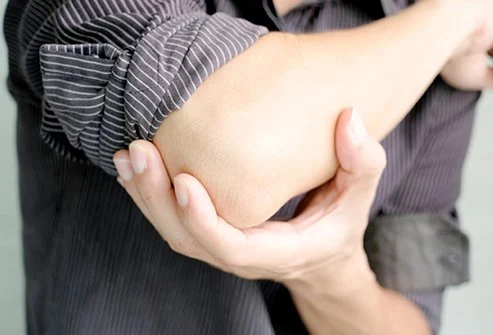
How can I take care of my tennis elbow?
Share
Tennis elbow can hurt even if you never pick up the racket. This happens when the tendons that connect the muscles of the forearm to the bones of the elbow become inflamed.
The tennis backhand is just one of many repetitive movements that can strain muscles and tendons. Others include painting, woodworking, playing a musical instrument or using heavy tools.
When you have persistent problems with your elbow, be sure to see your doctor so you can be diagnosed and on the road to recovery. If you do have tennis elbow, they can suggest the best treatment plan for you - from pain relief to surgery.
Here are self-care tips for managing your pain, healing faster, and trying to avoid the problem again.

rest your elbows
This situation comes from repetition and overuse. Rest your elbows as much as possible.
If your injury really comes from tennis or other racket sports, try another exercise that's not as tough on the elbow until you get better.
Work is naturally trickier because you can't always leave work like a hobby. Ask your boss about other tasks you can do while your elbow heals.
But when you're resting, keep this mantra in mind: "Absolute rest is rust." Your tendons need some tension and movement. When you use -- but don't overuse -- your arms, here are a few tips:
-
Learn to use the shoulder and upper arm muscles to relieve pressure on the elbows.
- Stick to the middle of your range of motion - try not to bend or straighten your arms.
pain management
Tennis elbow can be painful. Some ways to relieve pain include:
Over-the-counter pain relievers: ibuprofen and naproxen can relieve mild to moderate pain. These are called NSAIDs -- NSAIDs -- and they also reduce inflammation. Discuss taking these medications with your doctor, especially if you need it for several weeks.
Ice: Ice packs can also reduce swelling and pain if you don't like taking your medicine or want to take less medicine. Use several times a day for about 15 minutes each time.
Braces, splints, gears and tools
Some of the following may help with your recovery:
-
Braces: Wearing a support brace on your forearm may also help reduce stress on your elbow tendons. Discuss with your doctor or physical therapist whether you should use the correct forearm brace for you.
-
Splints: You may ask your doctor about using a wrist splint at night. This allows your muscles and tendons to rest.
So, does a tennis elbow brace really work? They should not be considered effective treatments for several reasons: Immobilization - Splints, braces, straps, and sleeves reduce elbow movement so your muscles, tendons, and joints remain stationary. This results in decreased blood circulation, which means less blood flow and oxygen to the tendon.
Should I wear a tennis elbow brace at night?
By doing this, they help reduce the pressure on the tendon in the injured elbow, which can help reduce the pain that keeps you up at night. These braces help keep your forearm muscles from fully contracting, which is great for your tennis elbow if you usually clench your fists at night.
How to sleep comfortably with tennis elbow
To avoid stressing your elbows as you recover from tennis elbow, you should sleep on your back and try to keep your arms in a straighter, more naturally relaxed position. It helps support each arm on pillows on either side of you.
Sports gear: If tennis is really at the root of your tennis elbow, a stiffer racket and looser strings may help once you're ready for some light play again. Some other tips:
-
Work with a tennis pro to improve your swing so you don't overwork your elbows again. The same idea applies to other racket sports.
- Make sure you have fresh, dry tennis balls. Wet or "dead" tennis balls can aggravate your elbows.
- Lastly, be sure to warm up and stretch your arms slightly before doing racquet exercise (or any exercise, really).
Tools for the job: If the on-the-job equipment works, you may need to try a different tool or technique. Seek advice from your physical therapist. Some other tooltips:
-
Hold the tool loosely; if you can, take some of the tension out of your hands.
- Use a padded hammer to help absorb shock.
- Get some training on different methods of working.
- If possible, use power tools instead of hand tools.
after physical therapy
One of the best ways to treat stubborn tennis elbow is physical therapy. It improves blood flow to the tendon, which will also speed up healing. Your therapist may also teach you ways to change your tennis shot or other activities that are causing your elbow problems.
Keep the momentum going even after your treatment plan is complete. Once your elbow is free of pain and your backhand is better than ever, you should keep your muscles strong and flexible.
That's because daily activities don't keep your muscles as strong and flexible as they should be to avoid sports injuries.










